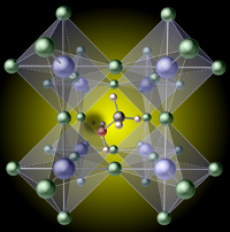New Materials to Improve Solar Cell Efficiency
October 12, 2021

A missing hydrogen atom in this prototypical hybrid perovskite was found to cause massive energy losses. Image: Xie Zhang.
Science Achievement
New research based on calculations run on NERSC’s Cori supercomputer has shown that, counter to common beliefs, all-inorganic materials known as perovskites have the potential for greater energy generation efficiencies in solar cells compared to materials currently being used. The University of California at Santa Barbara research team’s results were featured on the cover of the October 20, 2021 journal Cell Reports Physical Science.
Significance and Impact
Hybrid organic-inorganic perovskites have already demonstrated very high photovoltaic efficiencies of greater than 25%. The prevailing wisdom in the field is that the organic (carbon- and hydrogen-containing) molecules in the material are crucial to achieving this impressive performance because they are believed to suppress energy-losing “nonradiative recombination” events. The new research has shown that this assumption is incorrect and all-inorganic materials have the potential to outperform hybrid perovskites.
Research Details
The researchers ran comprehensive simulations of inorganic and hybrid materials, examining how the recombination events occurred. The simulations showed that organic molecules in the hybrid perovskite can break up, which strongly decreases efficiency. Inorganic perovskites are more difficult to create experimentally, but recent research has shown that their production is feasible.
Related Links
Zhang, Xie; Turiansky, Mark E.; Van de Walle, Chris G., "All-inorganic halide perovskites as candidates for efficient solar cells"; Cell Reports Physical Science, 2:100604; 2021 Oct 12, 10.1016/j.xcrp.2021.100604
About NERSC and Berkeley Lab
The National Energy Research Scientific Computing Center (NERSC) is a U.S. Department of Energy Office of Science User Facility that serves as the primary high performance computing center for scientific research sponsored by the Office of Science. Located at Lawrence Berkeley National Laboratory, NERSC serves almost 10,000 scientists at national laboratories and universities researching a wide range of problems in climate, fusion energy, materials science, physics, chemistry, computational biology, and other disciplines. Berkeley Lab is a DOE national laboratory located in Berkeley, California. It conducts unclassified scientific research and is managed by the University of California for the U.S. Department of Energy. »Learn more about computing sciences at Berkeley Lab.







